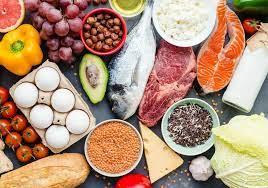Micro nutrients and Balanced diet
MicronutrientsNutrients required in very little amount but are significant to our body are called micronutrients.They are of the following types :1. VitaminsBased on solubilit...

Introduction :
Firstly, nutrition is the process of obtaining food necessary for every biological process. The food which is in taken is called nutrients . This can be obtained from others(heterotrophic) or by own self (autotrophic).
Types of nutrition :
The process where organism produces their food by themselves using simple inorganic materials and feed themselves and others too.
They can be divided into following two subtypes
a. Photo trophic nutrition : The process where organism produces their own nutrients using light.
B. Chemotrophic nutrition: The process where organism produces their own nutrients using chemicals. For instance, Sulphur bacteria oxidizes hydrogen sulphide to Sulphur producing nutrients in form of energy.
The process where organism directly or indirectly obtain nutrients produced by autotrophs. There can be of following three subtypes:
Holozoic nutrition : This process involves taking complex organic materials as a whole and breaking down to simple materials which are observed from digestive tract and utilized by different cells of the body .This type of Nutrition is characteristic to animals.
Parasitic nutrition: This involves obtaining nutrients from off host which provides food or shelter to the parasite and obtained directly the nutrients from the host .They can be either ectoparasites like leeches and fleas or endoparasites like Plasmodium.
Saprophytic nutrition: In this nutrition saprophytes obtain nutrients from dead and decaying matters .For example Mucor, Rhizopus.
Macro nutrients
1. Carbohydrates
This is the main source of energy for our body. On average, a gram of it provides 4 kcal of energy. Chemically their general formula is Cn (H2O) n .
The general ratio of carbon, hydrogen and oxygen in carbohydrates is 1: 2: 1.
Chemically they are polyhydroxy derivatives of aldehyde and ketones or also referred as hydrides of carbon.
They can be classified on the basis of complexity :
1. Monosaccharides : simplest monomeric form . eg: glucose, fructose
2. Oligosaccharides : Polymer of at most 10 monomers. Eg : sucrose, raffinose, lactose
3. Polysaccharides : polymer of more than 10 monomers. For instance : cellulose, glycogen, starch . Key Differences :
| Monosaccharides | Oligo Saccharides | Poly saccharides |
|
|
|
|
|
|
|
|
|
Source : mainly cereals like rice wheat and maize , potatoes, dried beans, sugar, milk, honey fruits, vegetables .
 Daily requirements : for normal healthy adult 45 to 65 % of total calories must be taken per day .
Daily requirements : for normal healthy adult 45 to 65 % of total calories must be taken per day .
Functions
· Primary source of energy ; vital for daily chores.
· Structural formation also like cellulose in plants .
· Genetic importance as deoxy ribose and ribose sugar
· Energy reserve for future like glycogen in animals.
· Reduce absorption of cholesterol so helpful to have excess fats and prevent coronary diseases.
Deficiency : leads to marasmus which is calorie intake less than protein intake in diet.
2. Proteins
They are complex nitrogenous compound which are polymerized form of amino acids via peptide bond .
On the basis of complexity :
1. Simple protein : Only primary bond which is peptide bond present .
2. Conjugated protein : bonded with other compounds like carbohydrate called as glycoprotein.
3. Derived protein : proteins derived after partial hydrolysis of original ones eg : peptones, proteoses
Monomer amino acid are of 20 different types which can be classified in 2 types :
| Essential amino acids | Non essential amino acids |
|
|
|
|

Structure of amino acid where; R : Alkyl or phenyl group
Dietary source :
From animal : meat, milk, egg. They possess almost every amino acids .
From plants : pulses, cereals, beans, nuts .
Daily need : for healthy adult about 70 gm per day .
Functions :
· Main structure forming nutrient like collagen
· Enzymes like trypsin are all made up of proteins .
· Immunoglobulins for immunity are of proteins .
· Myoglobin ,ferritin which are proteins work for storage.
· Actin, myosin, troponin complex are proteins in muscles for movement
· They are secondary source of energy after carbs.
Deficiency : causes kwashiorkor i.e. protein intake less than required in diet.
3. Lipids
They are esters of fatty acids and alcohols like glycerol . The ratio of carbon hydrogen and oxygen is 1: 2: less than 1 .This differs from carbohydrates in proportion of oxygen which is 1 for carbohydrates.
Fatty acids : Carboxylic acid with carbon number from 12 to 18 mainly. fatty acids present can be saturated or unsaturated.
Classification :
| Simple lipids | Compound lipids | Derived lipids |
|
|
|
|
|
|
Sub types of simple lipids :
| Oils | Fats | Wax |
|
|
|
|
|
|
|
|
|
|
|
|
|
|
|
Dietary sources :
Animal source : dairy products like milk, ghee butter, cheese and many more , meats , fish.
Plant source : oil of coconut, mustard, sesame.

Daily requirement :
For healthy adult 50 gm fat per day.
Roles :
· Primary storage form of energy ; crucial for hibernating organisms like frog.
· Structural role as phospholipids in cell membrane .
· Thermal insulation for homeostatic state.
· Cholesterol; a derived lipid is must for steroid hormones like androgens ,for absorption of fat soluble vitamins and precursor of vitamin D too.
· Phosphoatidyl choline acts as respiratory surfactant in lungs to prevent its collapse.
Deficiency : phrenoderma or toad skin characterized by dry scaly skin, hair loss and poor wound healing.
Excess of anything is harmful while for lipids, it could be fatal as it risks atherosclerosis and eventually cardiac arrest .